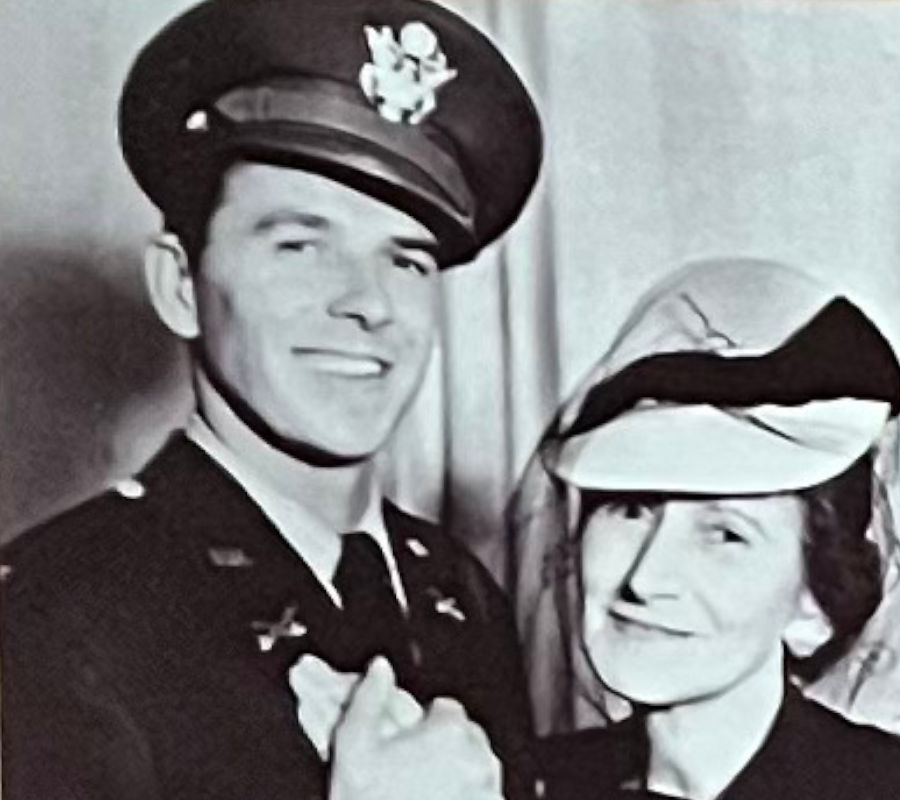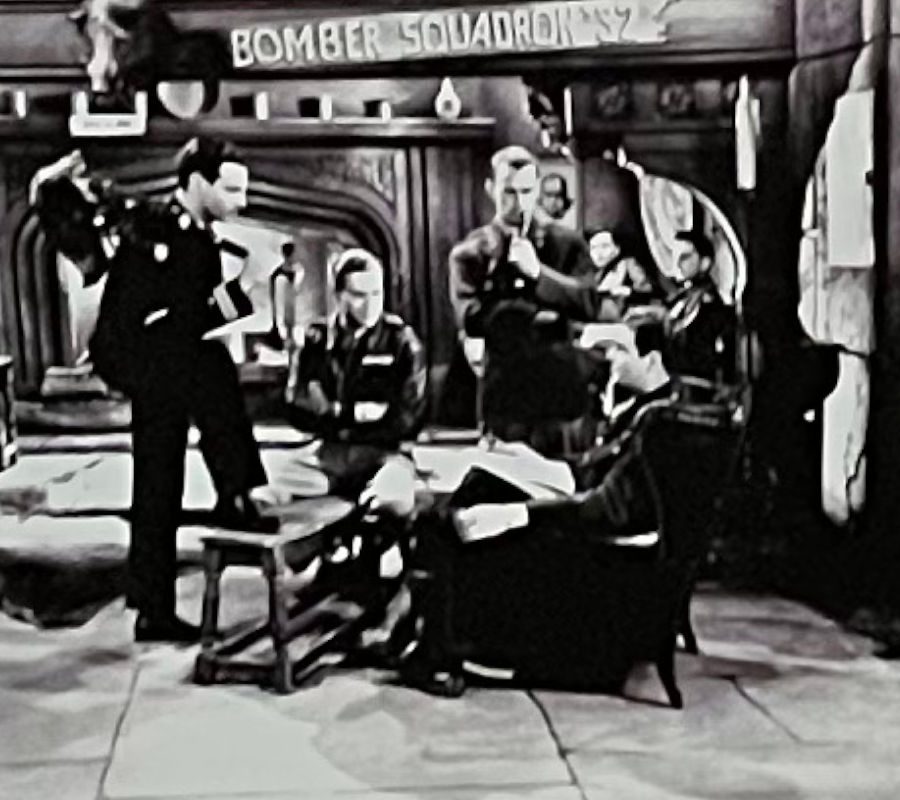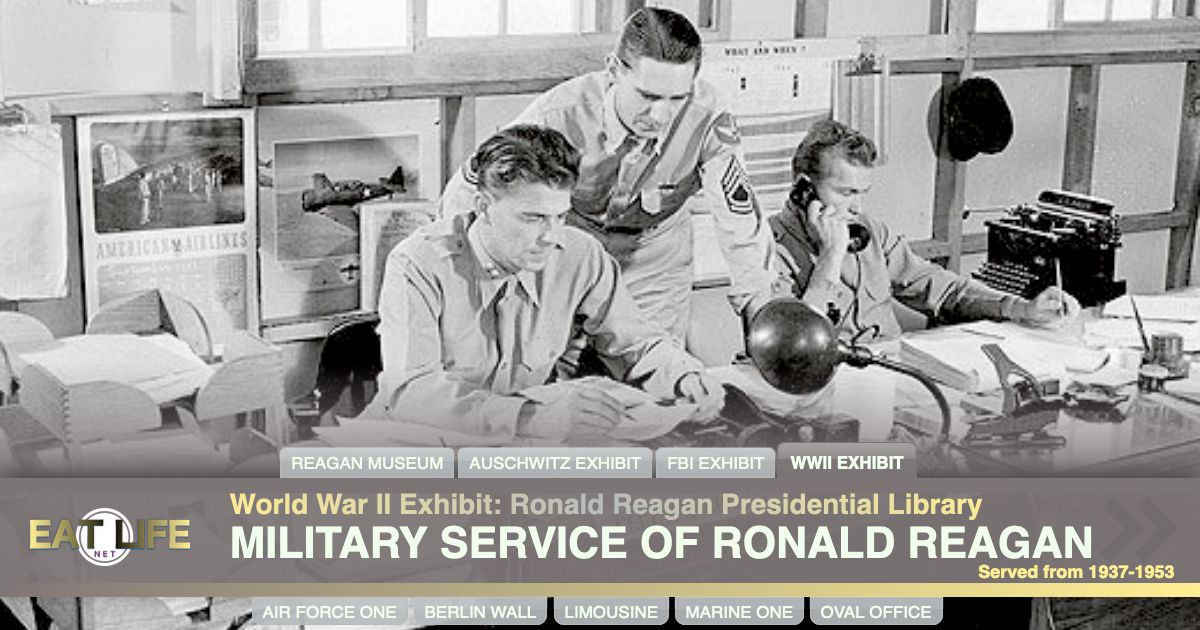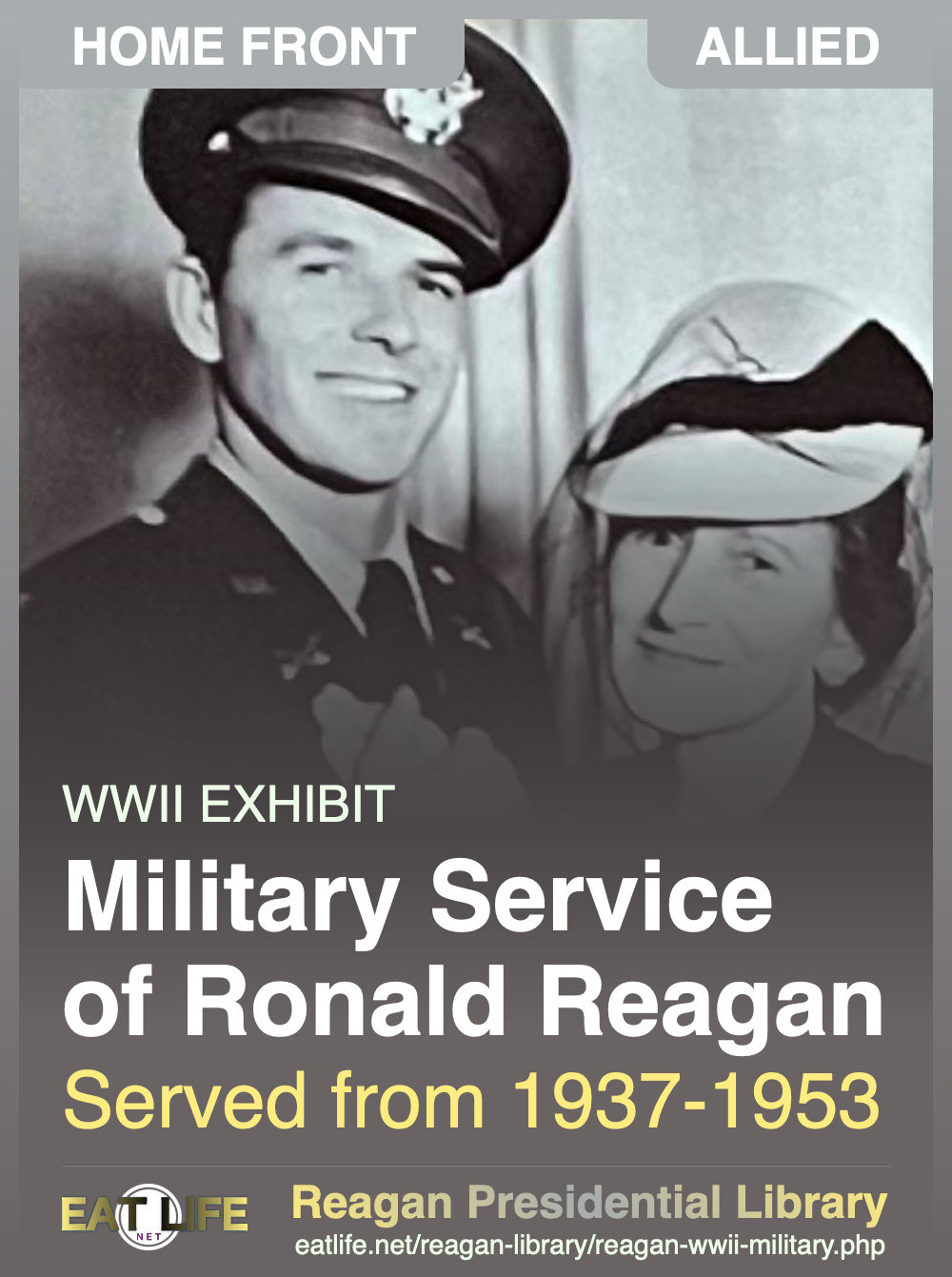He enlisted in the Army Enlisted Reserve in 1937 and was ordered to active duty in 1942. Due to his poor eyesight, he was excluding from serving overseas. He was assigned to AAF Public Relations and then to the 1st Motion Picture Unit in Culver City, California. He was promoted to Captain and served as Personnel Officer, Post Adjutant, and Executive Officer. By the end of the war, his units had produced some 400 training films for the Army Air Forces.
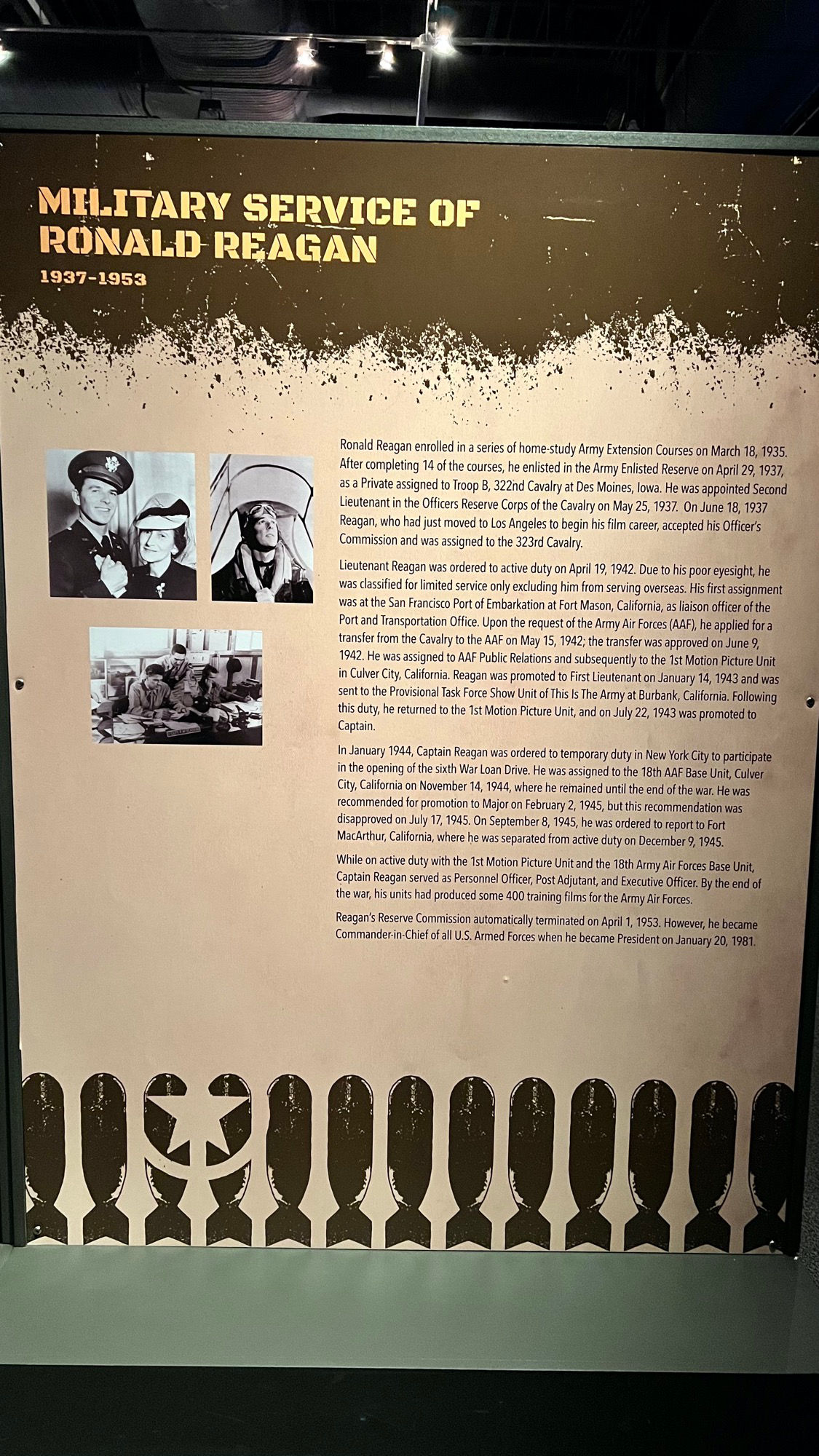
1937-1953
Ronald Reagan enrolled in a series of home-study Army Extension Courses on March 18, 1935. After completing 14 of the courses, he enlisted in the Army Enlisted Reserve on April 29, 1937, as a Private assigned to Troop B, 322nd Cavalry at Des Moines, lowa. He was appointed Second Lieutenant in the Officers Reserve Corps of the Cavalry on May 25, 1937. On June 18, 1937 Reagan, who had just moved to Los Angeles to begin his film career, accepted his Officer's Commission and was assigned to the 323rd Cavalry.
Lieutenant Reagan was ordered to active duty on April 19, 1942. Due to his poor eyesight, he was classified for limited service only excluding him from serving overseas. His first assignment was at the San Francisco Port of Embarkation at Fort Mason, California, as liaison officer of the Port and Transportation Office. Upon the request of the Army Air Forces (AAF), he applied for a transfer from the Cavalry to the AAF on May 15, 1942; the transfer was approved on June 9, 1942. He was assigned to AAF Public Relations and subsequently to the 1st Motion Picture Unit in Culver City, California. Reagan was promoted to First Lieutenant on January 14, 1943 and was sent to the Provisional Task Force Show Unit of This Is The Army at Burbank, California. Following this duty, he returned to the 1st Motion Picture Unit, and on July 22, 1943 was promoted to Captain.
In January 1944, Captain Reagan was ordered to temporary duty in New York City to participate in the opening of the sixth War Loan Drive. He was assigned to the 18th AAF Base Unit, Culver City, California on November 14, 1944, where he remained until the end of the war. He was recommended for promotion to Major on February 2, 1945, but this recommendation was disapproved on July 17, 1945. On September 8, 1945, he was ordered to report to Fort MacArthur, California, where he was separated from active duty on December 9, 1945.
While on active duty with the 1st Motion Picture Unit and the 18th Army Air Forces Base Unit, Captain Reagan served as Personnel Officer, Post Adjutant, and Executive Officer. By the end of the war, his units had produced some 400 training films for the Army Air Forces.
Reagan's Reserve Commission automatically terminated on April 1, 1953. However, he became Commander-in-Chief of all U.S. Armed Forces when he became President on January 20, 1981.
PBSRonald Wilson Reagan
Born in Tampico, Illinois on February 6, 1911
His father, Jack, was a failed businessman and alcoholic; his mother, Nelle, a charitable and religious woman. The family moved frequently before settling in Dixon, a small midwestern town which Reagan later idealized as "a place were life was wholesome…people trusted each other, and nobody locked his door at night."As a teenager Reagan spent summers working as a lifeguard at the local beach on the Rock River, where in 7 years he saved 77 lives. Reagan clung to this image of himself as a hero throughout his life. The Rock River, said Reagan biographer Edmund Morris, was "the central symbol of his youth."
Reagan did not distinguish himself academically during his four years at Eureka College, but he was successful as both a football player and as an actor in school plays. He graduated in 1932, during the Depression. After six weeks, the man who would become known as the "Great Communicator" was hired by an Iowa radio station as a sportscaster.
In 1937 Ronald Reagan went to Hollywood. Under contract to Warner Brothers, he was repeatedly cast as himself, or a very close facsimile. In his first role in Love Is on the Air he played a radio announcer. His roles called for him to be wholesome and Midwestern and often, a hero. After years as a "B" actor, Reagan gained recognition for his role as football hero George Gipp in Knute Rockne, All American and Drake McHugh in Kings Row.
One of his most successful roles was as Ronald Reagan himself. Reagan and Jane Wyman, married in 1940, starred in Hollywood's quest to cultivate an image of innocence. Soon after America entered the war, Reagan left Wyman and baby daughter Maureen (Michael was adopted in 1946) in Los Angeles to serve in the Army Air Force Motion Picture Unit in Culver City, 19 miles away. Here Captain Reagan starred in training and inspirational films filled with uplifting stories.
Ronald Reagan
Motivation on the Home Front in World War II
Inspiring Americans from War to the PresidencyNational Park ServiceRonald Reagan Enlisted in the US Army Reserves in 1937
He quickly advanced from private to second lieutenant and was assigned to a cavalry unit in Des Moines, Iowa. It was during this time that he moved to Los Angeles to begin his film career where he transferred to yet another cavalry unit as a young officer.Soon after the United States declared war on the Axis powers, Lieutenant Reagan was ordered to active duty in early 1942. Eager to continue as a cavalry officer, the young officer discovered that due to eyesight difficulties, he was classified for limited service only. This would exclude him from serving overseas.
Undaunted, Ronald Reagan insisted on finding a way to serve his country as an Army officer. After a brief assignment in San Francisco at Fort Mason, California with a cavalry unit, he received a request from the Army Air Forces (AAF) in search for skilled public relations officers.
It was here that Lieutenant Reagan found his calling as a gifted spokesperson and motivational leader for the war effort. Soon Reagan’s commanders noted his acting abilities and reviewed his earliest motion picture work which included a dozen films from 1937 – 1942. This included “Recognition of the Japanese Zero Fighter” (1942) portraying Lt. Sanders and Reagan’s narration for both “Beyond the Line of Duty” and “Cadet Classification” (1942-43). His Academy-Award nomination for his role as Lieutenant Ames in the 1943 film “Rear Gunner” most likely sold every one of his immense talent. Impressed, he was assigned to AAF Public Relations and subsequently to the 1stMotion Picture Unit in Culver City, California.
Reagan’s first film in his capacity officially supporting the war effort at home was “This Is the Army” produced by Hal B. Wallis, Jack L. Warner, and directed by Michael Curtiz which was an adaptation of a wartime stage musical. The War Department noted the box office success’ effect on boosting morale. Ronald Reagan and actor Alan Hale, Sr. were both lauded for their performances. The film was an Academy Award Win-Scoring of a Musical Picture; Academy Award Nomination-Best Sound.
In January 1944 Ronald Reagan was promoted to Captain. He served with the War Department’s command in New York City to participate in the opening of the sixth War Loan Drive. Home front economics in times of war are challenging at best. The United States government at the direction of President Franklin Roosevelt knew if Americans did not sacrifice some personal economic needs and show a willingness to invest in their government to fund the war effort, the United States could easily fall short in supplying the allied effort which at various times during the war was on the brink of collapse. The answer was war bonds issued by the government to finance military operations and other expenditures. The bonds also removed money from circulation and to help to control inflation. The government needed the conviction of a dedicated military officer combined with someone who could inspire and motivate. People were being asked to sacrifice to support their nation. It wasn’t always easy. Ronald Reagan did more behind the scenes to bring people together and ensure the war effort was continually funded in a way that ensured a timely end to years of devastation and misery. He was one of thousands of unsung heroes behind the scenes.
In 1945 Reagan was promoted to the rank of major. He continued to provide narration for patriotic films to include Target Tokyo, The Fight For The Sky, The Stillwell Road, and Wings For This Man all produced in 1945.
Ronald Reagan would again put these skills to the test when he assumed the U.S. Presidency in 1980. The nation was at an emotional low point following the Vietnam war and domestic unrest. Americans were uncertain of their futures. Inflation was out-of-control. The national image needed a face lift. People needed something to believe in. Undoubtedly President Reagan drew upon his services during World War II to help inspire a nation for a second time.
Ronald Reagan enrolled in a series of home-study Army Extension Courses on March 18, 1935. After completing 14 of the courses, he enlisted in the Army Enlisted Reserve on April 29, 1937, as a Private assigned to Troop B, 322nd Cavalry at Des Moines, Iowa. He was appointed Second Lieutenant in the Officers Reserve Corps of the Cavalry on May 25, 1937. On June 18, 1937 Reagan, who had just moved to Los Angeles to begin his film career, accepted his Officer's Commission and was assigned to the 323rd Cavalry.Lieutenant Reagan was ordered to active duty on April 19, 1942. Due to his poor eyesight, he was classified for limited service only excluding him from serving overseas. His first assignment was at the San Francisco Port of Embarkation at Fort Mason, California, as liaison officer of the Port and Transportation Office. Upon the request of the Army Air Forces (AAF), he applied for a transfer from the Cavalry to the AAF on May 15, 1942; the transfer was approved on June 9, 1942. He was assigned to AAF Public Relations and subsequently to the 1st Motion Picture Unit in Culver City, California. Reagan was promoted to First Lieutenant on January 14, 1943 and was sent to the Provisional Task Force Show Unit of This Is The Army at Burbank, California. Following this duty, he returned to the 1st Motion Picture Unit, and on July 22, 1943 was promoted to Captain.
In January 1944, Captain Reagan was ordered to temporary duty in New York City to participate in the opening of the sixth War Loan Drive. He was assigned to the 18th AAF Base Unit, Culver City, California on November 14, 1944, where he remained until the end of the war. He was recommended for promotion to Major on February 2, 1945, but this recommendation was disapproved on July 17, 1945. On September 8, 1945, he was ordered to report to Fort MacArthur, California, where he was separated from active duty on December 9, 1945.
History.comMay 15, 1942
Lieutenant Ronald Reagan, a cavalry officer, applies for reassignment to the Army Air Force, where he would eventually put his thespian background to use on World War II propaganda films.The transfer was approved on June 9, 1942, and Reagan was given a job as a public relations officer for the First Motion Picture Unit. The First Motion Picture Unit (FMPU)-its acronym was pronounced fum-poo-produced military training, morale and propaganda films to aid the war effort. FMPU released Frank Capra’s Why We Fight series and a documentary of the bomber Memphis Belle, the crew of which completed a standard-setting 25 bombing missions in Europe. The films were screened on domestic training grounds and in troop camps overseas as well as in movie theaters at home.
Another film, Air Force, which was later renamed Beyond the Line of Duty, conveyed the true story of the heroic feats of aviator Shorty Wheliss and his crew, featuring narration by Ronald Reagan. The documentary, originally intended to promote investment in war bonds, won an Academy Award in 1943 for best short subject. Reagan went on to narrate or star in three more shorts for FMPU including For God and Country, Cadet Classification and the The Rear Gunner. Reagan also appeared as Johnny Jones in the 1943 full-length musical film This is the Army.
How Playing a Pilot in WWII Docs Helped Reagan Launch His Political Career
Timing is everything-for an actor, and for a presidentHistory.comRonald Reagan always thought World War II had cost him his chance at reaching the top of the marquee of Hollywood stars. His best performance came in a film, Kings Row, that premiered just as the movie business was following other industries in converting to wartime production. By the end of the war, Reagan’s moment had passed, and it never came again.In truth, there was more to the story than bad timing. Reagan simply didn’t have the dramatic chops of Henry Fonda or Jimmy Stewart. Reagan was a fine supporting actor, but he couldn’t carry a film. Jack Warner, Reagan’s boss at Warner Bros. studio, understood. Told in 1965 that Reagan was running for California governor, Warner reportedly quipped, “No-Jimmy Stewart for governor; Ronald Reagan for best friend.”
Yet whether or not World War II derailed Reagan’s movie career, it put him on the path to another career, in which he reached greater heights than he ever could have in Hollywood. Reagan entered the military and was informed that he could do his country the most useful service by continuing to make movies. His eyesight was too poor to risk assigning him to any active theater of the war. “If we sent you overseas you’d shoot a general,” an examining doctor told him, as Stephen Vaughn writes in Ronald Reagan in Hollywood. “And you’d miss him,” the doctor’s colleague added.”
So Reagan reported to Culver City, California, where Jack Warner had set up the U.S. Army’s First Motion Picture Unit. Actors and technicians in uniform made promotional and instructional films, chiefly for the Army’s Air Forces. Reagan had played a pilot in earlier films and was a natural for an airman. He’d been a radio announcer before becoming an actor, and his voice was perfect as the narrator for inspirational documentaries about America’s heroes of the air.
Reagan’s wartime roles caused audiences to see-and hear-him in a new light. Though he never came under enemy fire, to many Americans he was the face and voice of those who did. Newsreel footage of actual battles left most of the participants too distant or blurry to be recognizable; the studio-quality films Reagan appeared in showed his camera-friendly looks to admirable effect.
More important, the war changed Reagan’s perceptions. He paid increasing attention to politics-first the politics of the film industry, then the politics of the country. Before the war he had never thought seriously about America’s role in world affairs, or the nation’s place in world history. Now he did.
As president of the Screen Actors Guild, and later as a representative of the General Electric Co., he embarked on a program of self-education. Increasingly he spoke out on the challenges facing the United States as the World War II struggle against fascism segued into the Cold War confrontation against communism.
By the time he entered elective politics, in the race for California governor, he had a grasp of public affairs that belied the popular perception of him as a washed-up actor who simply read scripts written by others. In fact, during his White House years, Reagan probably wrote more of his own lines than any president since Woodrow Wilson.
WIKIPEDIARonald Reagan
Reagan graduated from Eureka College in 1932 and began to work as a sports broadcaster in Iowa. Reagan arrived at Hollywood in 1937, debuting in Love Is on the Air (1937). Using a simple and direct approach to acting and following his directors' instructions, Reagan made thirty films, mostly B films, before beginning military service in April 1942. He broke out of these types of films by portraying George Gipp in Knute Rockne, All American (1940), which would be rejuvenated when reporters called Reagan "the Gipper" while he campaigned for president of the United States. Afterward, Reagan starred in Kings Row (1942) as a leg amputee, asking, "Where's the rest of me?" His performance was considered his best by many critics. Reagan became a star, with Gallup polls placing him "in the top 100 stars" from 1941 to 1942.World War II interrupted the movie stardom that Reagan would never be able to achieve again as Warner Bros. became uncertain about his ability to generate ticket sales. Reagan, who had a limited acting range, was dissatisfied with the roles he received. As a result, Lew Wasserman renegotiated his contract with his studio, allowing him to also make films with Universal Pictures, Paramount Pictures, and RKO Pictures as a freelancer. With this, Reagan appeared in multiple western films, something that had been denied him working at Warner Bros. In 1952, he ended his relationship with Warner Bros., but went on to appear in a total of 53 films, his last being The Killers (1964).
From 1947 to 1952, Reagan served as the president of the Screen Actors Guild. During the 1950s, he worked in television and spoke for General Electric. From 1959 to 1960, he again served as the Screen Actors Guild's president.
In April 1937, Reagan enlisted in the United States Army Reserve. He was assigned as a private in Des Moines' 322nd Cavalry Regiment and reassigned to second lieutenant in the Officers Reserve Corps. He later became a part of the 323rd Cavalry Regiment in California. As relations between the United States and Japan worsened, Reagan was ordered for active duty while he was filming Kings Row. Wasserman and Warner Bros. lawyers successfully sent draft deferments to complete the film in October 1941. However, to avoid accusations of Reagan being a draft dodger, the studio let him go in April 1942.
Reagan reported for duty with severe near-sightedness. His first assignment was at Fort Mason as a liaison officer, a role that allowed him to transfer to the United States Army Air Forces (AAF).
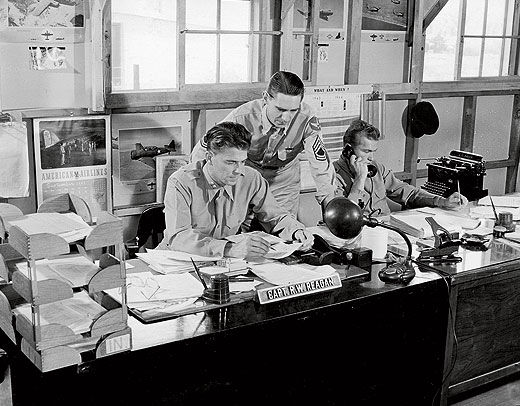 Captain Ronald Reagan in the Army Air Force working for the 1st Motion Picture Unit in Culver City, California. 1943
Captain Ronald Reagan in the Army Air Force working for the 1st Motion Picture Unit in Culver City, California. 1943Reagan became an AAF public relations officer and was subsequently assigned to the 18th AAF Base Unit in Culver City where he felt that it was "impossible to remove an incompetent or lazy worker" due to what he felt was "the incompetence, the delays, and inefficiencies" of the federal bureaucracy. Despite this, Reagan participated in the Provisional Task Force Show Unit in Burbank and continued to make theatrical films. He was also ordered to temporary duty in New York City to participate in the sixth War Loan Drive before being reassigned to Fort MacArthur until his discharge on December 9, 1945, as a captain. Throughout his military service, Reagan produced over 400 training films.
